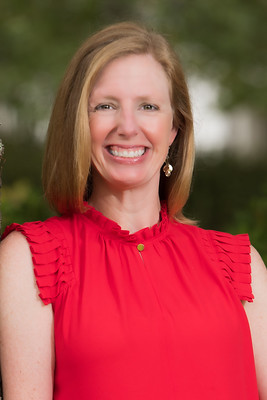content body
It was spring 2020. Morgan Yordy’s husband had just passed away unexpectedly, COVID-19 had brought normal life to a halt and she and her three young children were overwhelmed and grieving.
So, who provided them with comfort in the most difficult of times? It was their family poodle, Clarabelle, and a goldendoodle named Daisy, a therapy dog from Auburn University’s College of Nursing.
A faculty member and a program director of the college’s CAREing Paws program, Yordy has spent years studying the relationship between canines and humans, but it wasn’t until she witnessed it in her own home that she realized just how much dogs can help people heal from trauma.

Morgan Yordy is a faculty member and a program director of the College of Nursing's CAREing Paws program,
“I went into supermom mode doing whatever I could to make sure my babies could make it,” she said. “They were only 4, 7 and 9 years old. We had our Poodle and one of the CAREing Paws therapy dogs at home during that time, and it was then that I recognized what a godsend those dogs were. My children didn’t necessarily want to talk to me, but they could talk to the dogs.”
Yordy has been with the College of Nursing since 2016 but has been studying animal-assisted therapy since 2011. She originally focused her research on the benefits of using therapy dogs with dementia patients.
When she began working with the College of Education’s Malti Tuttle, her research shifted from geriatrics to school-aged children. Soon a colleague at the University of Arkansas asked her to bring her expertise to the study of autism spectrum disorder.
“We’ve been trying to work collaboratively on how we can implement animals in schools to help with sensory emotional regulation, so the research has been continually morphing into what it is now,” she said.
Working alongside Tuttle and other colleagues in nursing and education, Yordy is currently studying the purposeful interactions dogs should be used for in schools, like literacy programs and hygiene education, as well as the pros and cons of bringing a canine into a school setting. She says that most people who have pets at home see only the upsides of having a dog at school, but other professionals, including school nurses, recognize there are drawbacks.
“Nurses see the health aspects of it – allergies, dog bites, a fear of dogs,” she said. “And there are ethical concerns about bringing dogs into schools because, again, many people may like them, but some have fears and there are religious and cultural aversions to dogs. Unfortunately, a lot of ethical considerations take a backseat because we do see so much positive work with dogs.”
Yordy works with Sensory Outreach Under Nurse Direction (SOUND), a program in the College of Nursing that provides resources for children with emotional regulation challenges. SOUND currently has space in Neville Arena, as well as a mobile Sensory Activation Vehicle that can be utilized outside of Jordan-Hare Stadium and at events throughout the community.
“There are many children who shy away from community events because of the noise, the atmosphere and that fear that COVID brought us,” she said. “You don’t necessarily have to have a diagnosis to experience sensory overload, so we’re trying to make it easier for them to join events.”
SOUND provides families with such resources as a quiet space, a comfy bean-bag chair, noise-muffling headphones and fidget toys. Yordy hopes to add animal-assisted intervention as an option for those children who find comfort in an animal, and the CAREing Paws program has added a golden retriever named Sully for this very purpose.
“Sully was specifically bred and trained for our mental health program,” Yordy said. “He was bred for calmness, intelligence, gentleness and the work ethic that a service dog would have. He’s not a service dog, but we are working very hard on training him for tasks that help autistic children, including calming behaviors like weightiness in a lap.”
Yordy is hoping Sully will be a regular at community events beginning next spring.
“When I started working closely with children during traumatic events, which could be anything from the loss of a parent or sibling, COVID or even something like a tornado, I could see how much animals could make a real impact,” she said.





